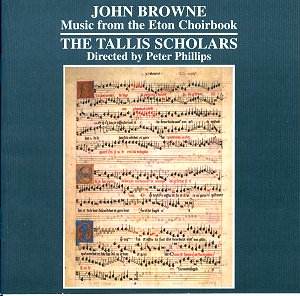This CD is one of those
few productions that leave me speechless.
And this is for two fundamental reasons.
The first is the sheer beauty and characteristic
poise of the performance by the Tallis
Scholars. The second is that in John
Browne we have an undoubted master who
is little known. Yet there is a perfection
in these five works that is rarely found
in music of any generation.
With the considerable
help of the programme notes I will try
to outline in a little more detail the
background to this ‘subtle and seductive’
music.
All the works on this
disc are to be found in the Folios of
the Eton Choirbook, dating from the
last decade of the fifteenth century.
There are some fifteen works by Browne
in these manuscripts. However, some
are lost completely and only appear
in the index, others are incomplete
and some are just too long to include
on this current retrospective.
Little is known about
John Browne. Suffice to say that he
was probably born in Coventry and at
the age of thirteen or fourteen was
elected as a scholar at Eton. This was
in 1467. He is regarded by scholars
as being pre-eminent amongst the composers
represented in the Eton Choirbook; his
contribution being both exceptional
musically and by far the largest in
quantity. Great things have been claimed
for him, for example it has been said
that he is ‘amongst the greatest composers
between John Dunstable and John Taverner.’
One of the strange
things about the five works presented
on this CD is that none of them are
composed for the same vocal forces.
Furthermore there is a tendency to use
voices from the lower range making for
some very interesting sounds. For some
reason, possibly lost to history, his
choice of texts seems to be profound
and serious, for example, there are
two versions of that most harrowing
of Christian mediations – Our Lady stood
at the foot of the Cross watching her
Son expire.
Musically, Browne is
noted for a greater flexibility of his
approach to counterpoint than many of
his contemporaries. For the technically
minded this included a preference for
imitation and a less than conventional
approach to the introduction of voices
into this particular musical device.
For those who know
John Browne’s music the Salve regina
and the Stabat mater have been
the two works which have kept his flame
alight over the centuries. Even the
most superficial hearing of these works
reveals why they have been so highly
regarded. There is much to discover
in these deeply moving works.
The Stabat iuxta
is unusual in its scoring. The composer
calls for four tenors and two basses.
This narrowing of musical compass to
two octaves makes for some interesting
sonic effects. Peter Philips states
that there are ‘opportunities for dense,
almost cluster chords.’ These defied
the contemporary textbook approach to
writing of polyphony which encouraged
a greater balance of texture and voicings.
The O Regina mundi has a similar
sound to the Stabat iuxta although
the composer has added an alto to give
contrast to the tenors and basses.
The 'magnus opus' is
undoubtedly the antiphon O Maria
salvatoris – O Mary Mother of the
Saviour. This work was highly regarded
in Browne’s lifetime. In fact it had
the honour of being at the very front
of the Eton Choirbook. Peter Philips
notes that at the time of the work’s
composition, there would have been no
precedent for 8-part polyphony, so it
would have been regarded as being somewhat
experimental and perhaps even avant-garde.
This is truly wonderful music that fair
takes the breath away. It well deserves
to re-establish its place in the canon
of ecclesiastical music.
This CD is beautifully
presented. There is something that feels
good about just holding it IN your hand,
even before putting it ‘onto the turntable.’
The cover shows an example of Browne’s
musical penmanship in the Stabat
mater; this is an artistic masterpiece
in its own right.
The sleeve-notes and
the translations are all present and
correct, and of course this is so necessary
when listening to music that is largely
known only to specialists. The sound
quality is, as with every CD I have
heard from Gimell, near perfect.
Taken as a whole this
is a gorgeous exploration into a realm
of music that is little known. Yet somehow
this is essential listening for all
who love liturgical music. This represents
all that is best in English music –
not only from the fifteenth century
but from any age.
Near perfect music
from the late fifteenth century sung
in glorious style. A most moving and
satisfying disc.
John France







